QUESTIONS
Answer all the questions.
- State the importance of each of the following living organisms:
- nutrition (1 mark)
- excretion (1 mark)
- nutrition (1 mark)
- What is meant by the term seed dormancy? (1 mark)
- State three causes of seed dormancy. (3 marks)
- What is meant by the term seed dormancy? (1 mark)
- State two functions of the placenta in mammals. (2 marks)
- The diagram below illustrates a growing pollen tube.
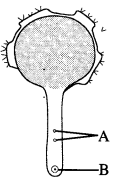
- Name the part labelled B. (1 mark)
- Explain the role of the parts labelled A. (2 marks)
- Name the part labelled B. (1 mark)
- The diagram below shows a set up for an experiment to demonstrate a certan physiological process.
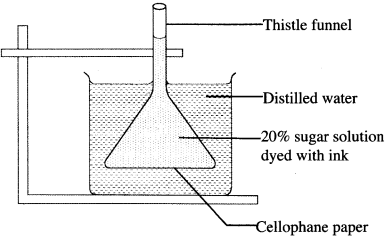
- What nature of solution is represented by 20% sugar solution? (1 mark)
- Explain the observation made on the set up after one hour. (2 marks)
- What nature of solution is represented by 20% sugar solution? (1 mark)
- State three roles of auxins in a plant stem. (3 marks)
- A student drew a 6cm long diagram of a plant flower. If the actual length of the flower was 12cm, calculate the magnification of the drawing made by the student. Show your working. (2 marks)
- Differenciate between phenotype and genotype as used in genetics. (1 marks)
- State two functions of intervertebral discs in the mammalian skeleton. (2 marks)
- Explain two roles of diffusion in human beings. (4 marks)
- What is meant by each of the following terms?
- Crenated cell (1 mark)
- Flaccid cell (1 mark)
- Explain two roles of diffusion in human beings. (4 marks)
- State three differences between tactic and tropic responses. (3 marks)
- The diagram below represents a model used to demonstrate breathing in mammals.
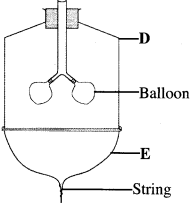
- Name the mammalian structure represented by the parts labelled D and E.
- D ( 1 mark)
- E (1 mark)
- State the observation made when the string is pulled downwards. (1 mark)
- Explain the observation in (b) above. (2 marks)
- Name the mammalian structure represented by the parts labelled D and E.
- State one function of each of the following parts of the mammalian eye:
- eye lashes (1 mark)
- lachrymal glands (1 mark)
- eye lashes (1 mark)
- State three structural differences between DNA and RNA. ( 3 marks)
- Which type of mammalian muscles is voluntary. (1 mark)
- Distnguish between tendon and ligament. (1 mark)
- Which type of mammalian muscles is voluntary. (1 mark)
- The diagram below illustrates a nerve cell.
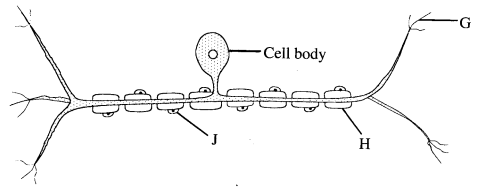
- Name the type of nerve cell illustrated. (1 mark)
- Give a reason for your answer in (a) above. (1 mark)
- Identify the part labelled J. (1 mark)
- State one function of each of the parts labelled G and H.
- G (1 mark)
- H (1 mark)
- Name the type of nerve cell illustrated. (1 mark)
- Give a reason why the image is not formed when light is focused on the blind spot. (1 mark)
- Explain why
- mammalian testes are located to hang outside the body. (2 marks)
- four months after fertilisation, ovaries can be removed from a huma n female, without terminating pregnancy. (2 marks)
- mammalian testes are located to hang outside the body. (2 marks)
- Why is a burning charcoal stove in a poofy ventilated room likely to cause death of the inhabitants? (3 marks)
- State one function of each of the following cell organelle:
- golgi bodies (1 mark)
- lysosomes (1 mark)
- Name the type of skeleton that amkes up each of the following animals:
- locust (1 mark)
- bird (1 mark)
- locust (1 mark)
- Name two vestigial structures in human beings. (2 marks)
- Why are some bacteria unable to resist the effect of antibiotics? (2 marks)
- Name two vestigial structures in human beings. (2 marks)
- Below is an illustration of a cross section of a plant root showing the transportation of substances in the plant.
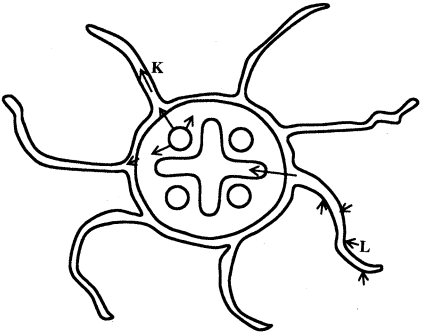
- Name the substances transported along the parts labelled K and L.
K (1 mark)
L (1 mark) - Give a reason for your answer in L above. (1 mark)
- Name the substances transported along the parts labelled K and L.
- The diagram below shows the transportation of substances in a human body.

Name the substances represented by
M (1 mark)
N (1 mark)
P (1 mark) - State two roles of luteinising hormone in human reproduction. (2 marks)
- The table provided shows the concentration of sodium and iodine in sea water and cell sap of plant.

- Name the process through which plant cells take up sodium ions. (1 mark)
- Give a reason for your answer in (a) (i) above. (1 mark)
- If the plant was sprayed with with a chemical that inhibits respiration:
- which of the two ions uptake will be affected? (1 mark)
- give a reason for your answer in (b) (i) above. (1 mark)
- The diagram below shows the gaseous exchange system of a locust.
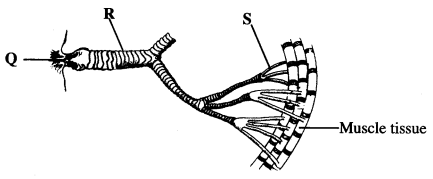
- Name the structure labelled Q. (1 mark)
- State the function of the part labelled R. ( 1 mark)
- How is the part labelled S structurally adapted to its function? (2 marks)
- Name the structure labelled Q. (1 mark)

MARKING SCHEME
-
- Acquisition and utilization of nutrients; (1 mark)
- Elimination of metabolic wastes to prevent accumulation to toxic level;(1 mark)
-
- A period of rest in which a seed performs its physiological processes slowly and utilizes little food; (1 mark)
-
- Chemical/growth inhibitors;
- Hard/impermeable seed coat;
- Low / freezing temperatures;
- Under developed embryo/immature embryo;
- Low concentration of hormones;
- Lack of appropriate light wavelength;
(max 3 marks)
-
- Exchange of nutrients /metabolic wastes/gases between the mother and foetal circulatory systems;
- Secretion of progesterone hormone;
(2 marks)
-
- Tube nucleus;
-
- One male nucleus fuses with the egg cell nucleus to form a zygote;
- The other male nucleus fuses with the polar nuclei to form the endosperm;
(2 marks)
-
- Hypertonic solution; (1 mark)
- Volume of sugar solution increases in the thistle funnel while that of distilled water in the beaker reduces; because the thistle funnel gains distilled water by osmosis.(2 marks)
-
- Cell division;
- Cell elongation;
- Development of adventitious roots;
- Formation of callus tissue;
- Causes apical dominance;
- Causes tropic responses.
3 x 1 (3 marks)
- Object length = 12 cm
Drawing length = 6 cm
Mg = Drawing length ; = 6
Object length 12
= X 0.5;
(2 marks) - Phenotype is the outward appearance of an organism while Genotype is the genetic make up of an organism; (1 mark)
- Act as shock absorbers;
Allow smooth movement between the vertebrae/reduce friction;
(2 marks) -
-
- Absorption of materials e.g. diffusion of digested food into the blood stream;
- Gaseous exchange e.g. CO2/O2 diffuses from capillaries into the alveoli.
- Excretion of nitrogenous wastes; e.g urea diffuses from blood capillaries into the elimination sites. (max 4 marks)
-
- Crenated cell is a shrunk animal cell that has lost water by osmosis;(1 mark)
- Flaccid cell is a flabby /shrunk plant cell that has lost waster by osmosis;(1 mark)
-
-
(3 marks)Tactic Responses Tropic Response Are locomotory Are growth responses; Are fast Are slow Not influenced by growth hormones Are caused by growth hormones; Temporary Permanent -
-
- Rib-cage/chest cavity; (1 mark)
- Diaphragm; (1 mark)
- The balloons are inflated; (1 mark)
- Pulling down the string increases the volume of D, hence decreasing the pressure inside;
The low pressure causes external atmospheric air to rush in and inflate the balloons;
(2 marks)
-
-
- Trap foreign particles entering the eye;
Produce fluid/tears; (1 mark) - Moistens the cornea;
Wash foreign materials out of the eye;
Antiseptic / kills harmful microorganisms; (max 1 mark)
- Trap foreign particles entering the eye;
-
(3 marks)DNA RNA Double stranded/double relix Single stranded; Has Thymine Thymine is replaced by uracil/reject Thiamin; Has the four nitrogen base pairing pattern Lack the four nitrogen base pairing pattern; Deoxyribose sugar Ribose sugar; -
- Skeletal muscles / striated muscles; (1 mark)
- Tendon is a (inelastic) tissue that attaches muscles to bones while Ligament is a (inelastic) tissue that attaches a bone to another bone of a movable joint;(1 mark)
-
- Sensory neurone; (1 mark)
- Cell body is located off the axon/tied outside the CNS; (1 mark)
- Schwann cell; (1 mark)
-
- Receipt/transmits impulses to neighbouring neurons in the CNS from sense organs; (1 mark)
- Insulates the axon/accept dendron for axon; (1 mark)
- The blind spot lacks both cones and rods hence images are not perceived; (1 mark)
Accept photoreceptor cells for cones and rods; -
- To provide a cool environment; that is conducive for sperm formation; (2 marks)
- Progesterone hormone; is secreted by the placenta to maintain the pregnancy;
- Due to limited oxygen, haemoglobin combines with carbon (II) oxide to form carboxyhaemoglobin;(2 marks)
Carboxyhaemoglobin does not readily dissociate hence reduces the capacity of haemoglobin to transport oxygen; Carbon (II) oxide is therefore a respiratory poison if breathed in for a long time;(3 marks) -
- Packaging of substances/glycoproteins/ transportation of glycoproteins;
Secretion of synthesized proteins and carbohydrates;
Formation of lysosomes/modification of carbohydrates to form glycoproteins;
(1 mark) - Digestion of food/Breakdown large molecules;
Destroy worn out organelles or cells/tissue;
(max 1 mark)
- Packaging of substances/glycoproteins/ transportation of glycoproteins;
-
- Exoskeleton; (1 mark)
- Endoskeleton; (1 mark)
-
- Appendix/accept nictating membrane; coecum and ear drum;
Tail/coccyx; (1 mark) - They have a gene for resistance/acquire it through mutation;
The gene for resistance is passed to offsprings establishing a population of resistant forms;
(2 marks)
- Appendix/accept nictating membrane; coecum and ear drum;
-
- K - Photosynthetic products/manufactured foods example vitamins/alicose/proteins/ sucrose/maltose/fructose/lipids/nitrates; (1 mark)
L - Water and mineral salts; (1 mark) - The substances are moved into the star shaped xylem; (1 mark)
- K - Photosynthetic products/manufactured foods example vitamins/alicose/proteins/ sucrose/maltose/fructose/lipids/nitrates; (1 mark)
- M - lungs; (1 mark)
N - Urea, ammonia, ; (1 mark)
P - Digested food, water; mineral ions; (1 mark) -
- Stimulates maturation of the Graafian follicle/stimulates ovulation;
- Stimulates corpus luteum to secrete progesterone hormone;
- Stimulates release of androgens;
- Stimulates development of corpus luteum;
(2 marks)
-
-
- Diffusion; (1 mark)
- Sea water contains a higher concentration of sodium ions than the cell sap; (1 mark)
-
- Iodide ions; (1 mark)
- Sea water has a lower concentration of iodide ions than the cell.
The plant requires energy to take up the iodide ions (by active transport);(1 mark)
-
-
- Spiracle; (1 mark)
- Keep the trachea open for air passage; (1 mark)
-
- Lacks spiral bands of chitin / to make it thin; for diffusion of gases;
- Moist; to dissolve respiratory gases;
(2 marks)
Join our whatsapp group for latest updates
Tap Here to Download for 50/-
Get on WhatsApp for 50/-
Download KCSE 2014 Biology Paper 1 Questions with Marking Scheme.
Tap Here to Download for 50/-
Get on WhatsApp for 50/-
Why download?
- ✔ To read offline at any time.
- ✔ To Print at your convenience
- ✔ Share Easily with Friends / Students

